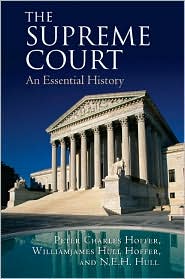Is the History of the U.S. Supreme Court Essential?

But in this popular media-based setting of juicy tidbits and behind the scenes interviews, what role is left the historian? Weighed against our national passion for locker room and conference room gossip, can a history of the Court still be essential to our understanding of its place in our system of government and law? That is a question that confronted the authors of The Supreme Court: An Essential History (Lawrence, Kans.: University Press of Kansas, 2007), of whom I am one.
A second, related question came to mind in the midst of our labors. "Why was another book on the Supreme Court necessary? Weren't there enough already? Wasn't it self-indulgent to write another? That quandary needed a response. Here it is: a question answered with questions: when is enough examination of our democratic institutions enough? When should we become content with the stories told of our past? When do we no longer need any more histories? When does rethinking history become, in the words of a president of the United States, the evil of 'revisionism' "?
Our brief for history, in answer to both questions of relevance and need, is simple. Without knowing its own history, the Court would suffer a particularly cruel amnesia. Without knowing the Court's history, Americans would conclude that every decision was nothing more than politics as usual. The Court needs history, and we need histories of the Court. Let me explain.
As we wrote, the justices of the Supreme Court themselves must look to history to help them decide cases. "They examine earlier decisions of the Court on past cases similar to the one they must decide at the moment. They also survey the events leading up to the case, in effect the case's own little history." They may ask "What did the framers of the Constitution and its amendments mean to say when they wrote those words? What did the words mean to people who lived then? Have those meanings changed over time?"
We must never forget that "the Court is itself a historical actor. When a bitterly divided Court opined, in 1857, that Congress could not prevent a slave owner from taking his or her property into the western territories, its decision brought the Civil War closer. The Court's refusal to allow New York to regulate its bakers' hours, in 1905, spurred reformers to find other ways to safeguard workers. When a unanimous Court announced, in 1954, that segregation in public schools was illegal, it opened a new chapter in the Civil Rights saga. By deciding that women had a right to determine whether they would carry a pregnancy to term, in 1973, the Court created a political furor that has continued to this day."
We concluded that "a history of the Court is essential because its operation is often obscure. The complexity of the cases the Court chooses to hear and decide cannot easily be explained to lay people. The deliberations of the Court are kept secret and cloak its operation and thinking from our inspection. The arcane language of the law in its opinions adds another layer of incomprehensibility to the Court's operation. The result may be incomprehension and anger, as when one majority leader of the House of Representatives, infuriated by High Court action he did not understand, called a press conference to denounce the High Court, as 'an arrogant, out of control, unaccountable judiciary' and warned 'The time will come for the men responsible for this to answer for their behavior.' A history of the Court can lift the veil on that obscurity. By placing their words in their historical context, going back to the time and occasion of their writing, one can gain a better and clearer perspective on the Court's labors. In effect, one can see behind the words to the ideas and intentions of the justices themselves."
Such a history lines out the larger contours of the Court's role, loosed from immediate controversies. The Court's history is neither fixed nor finished. Because the politics on the Court and the politics of the nation will continued to change; because the Court has the ability to revisit its own precedents, distinguishing and changing what it no longer believes to be good law; because the Constitution is a living document whose health the justices superintend; the Court can write its own history, and in the process, rewrite American law.